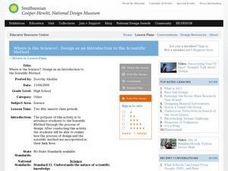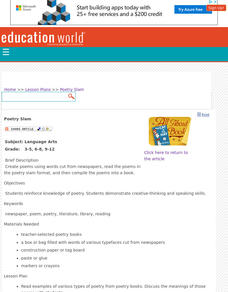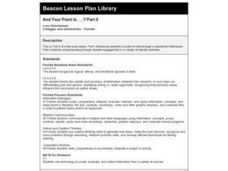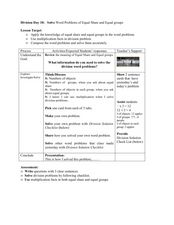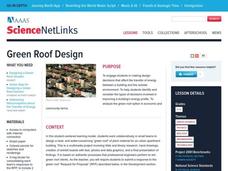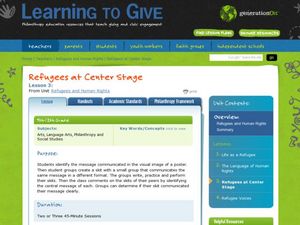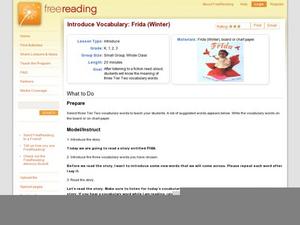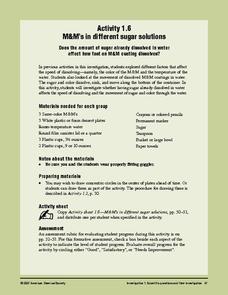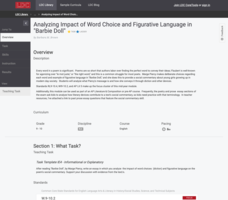Curated OER
Where is the Science?: Design as an Introduction to the Scientific Method
Students work to create a design that will protect an egg from being dropped from a one story floor. They test their prototype after it is completed. They write clear instructions and link aspects of the design process to the scientific...
Curated OER
Poetry Slam!
Create poems without writing! Young poets create poems using words cut from newspapers, read their poems aloud, and compile them in a book. This lesson allows the teacher to view each learner's creative process and assess their current...
Curated OER
And Your Point Is . . .? Part II
After researching recent community or political issues, paired with a review of proper debate format, class members select a topic, adopt a side, and prepare for a debate. The value in this resource is the review of debate procedures,...
Curated OER
Measurable You!
Conduct guided experiments and discussions while collecting anthropometric measurements. Your class will explore impact of experimental errors in a scientific system, and explain their observations/findings in writing. An introduction to...
Curated OER
Solve Word Problems of Equal Share
Youngsters solve division word problems. They will make their own division word problems using objects in equal groups. They share how they solved their problem with the class. Division worksheets are included to support the process....
Curated OER
Lesson: Elizabeth Peyton: The Self in the Other's Image: Portraiture and Identity
Art, identity, and an imaginary community, three components that should make for an interesting lesson. Critical thinkers explore and evaluate the work of contemporary artist, Elizabeth Peyton. They discuss her use of subject and art to...
Science NetLinks
Green Roof Design
Green roofs aren't just eco-friendly — they are literally green with trees. Groups learn about the concept of green roofs in order to be able to design one. The groups design a 5,000-square-foot green roof for a fictional apartment row...
Serendip
Homeostasis, Negative Feedback, and Positive Feedback
So many bodily activities depend on homeostasis! Give learners a solid background to understand the basic process of the human body. Scholars first examine negative feedback loops contributing to body temperature regulation and then a...
Curated OER
Swamps, Shrimp, and Tsunamis: A Simulation of Sustainable Development Issues in Coastal Ecuador
Young scholars examine the economic benefits, environmental losses and dangers of the shrimp farming industry on the coast of Ecuador. They read a script, role-play people involved in the shrimp business, and write an essay of the pros...
Curated OER
Student Newspaper Project
Writing teaches us so much. One can identify the many characteristics of a newspaper, use the Internet to gather information, and communicate with others. Primary students create a class newspaper for publishing and dispersal.
Canadian Museum of Civilization Corporation
Artifacts Tell Stories: Creating a First World War Museum in the Classroom
Although designed for the Canadian War Museum, the concept here is a solid one. Class members select an artifact from the First World War, examine it, research it, and craft an explanative label that they attach to their picture and post...
Washoe County School District
Eyewitness to the Holocaust
Scholars investigate the Holocaust through the eyes of an Auschwitz survivor. They analyze and research a firsthand account of events inside the gas chambers moments before hundreds died. Using Holocaust Reading Passages and...
Curated OER
Biography
Transform a written biography into a video biography! Introduce your learners to the biography format by reading them a few examples (some suggestions are included). Then discuss the factors that make a good biography. What information...
Curated OER
Talking Sticks Literature Circle
Following the six-step process for a talking sticks literature circle, group members choose a leader for the discussion, summarize the reading, discuss journal entries and questions, set reading goals, and write reflections. I think this...
Curated OER
Study Buddies: Fact Families
Second and third graders work with a coach to find multiplication and division fact families. They follow a step-by-step process and notes are provided for the coach.
Curated OER
Refugees at Center Stage
What is an advocate? Help high schoolers understand the issues forcing refugees to leave their home country. After gaining some information on the subject, high schoolers create a dynamic presentation and persuasive essay encouraging...
Chicago Botanic Garden
Review and Assessment: Causes and Effects of Climate Changes
The last activity in the series of five is a short one where individuals show what they've learned about the causes and effects of climate change. Working independently, they fill in a graphic organizer, then compare their notes with a...
Curated OER
The Perfect President
Students advertise for the perfect president. For this presidential duties lesson, students determine the attributes that the ideal president should have and then write job descriptions for the role.
Curated OER
Introduce Vocabulary: Frida (Winter)
Combine vocabulary in context with art history using Jonah Winter's colorful biography Frida. Although there are quite a few words you could teach from this text, four are listed here with connecting questions: ill, imitate,...
Pulitzer Center
China's Rising Labor Movement
Young historians will explore the complex causes and effects of industrialization in China by perusing the numerous articles included in this webpage. Throughout the resource, there are many writing and discussion prompts to help direct...
Curated OER
Natural Selection
Kids act as scientists and preditors in this short natural selection activity; they collect and analyze data, then apply their new knowledge to real-world examples of natural selection. The layout of the worksheet is easy enough to use...
American Chemical Society
M&M's in Different Sugar Solutions
To conclude a mini unit on the dissolving of M&Ms® candy coating, this lesson investigates whether or not the concentration of sugar in the solvent affects the dissolving rate. Consider having older science learners write their own...
EngageNY
Grade 9 ELA Module 3, Unit 2, Lesson 7
Now that learners have honed their inquiry-based projects down to their strongest few questions, they can conduct independent research. High schoolers pursue answers to their inquiries while assessing sources, establishing a research...
Literacy Design Collaborative
Analyzing Impact of Word Choice and Figurative Language in "Barbie Doll"
After a close reading Marge Piercy's poem "Barbie Doll," class members craft an AP®-style explanatory essay in which they analyze the diction and other figurative literary devices the poet employs to deliver her commentary on modern...
